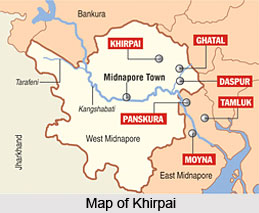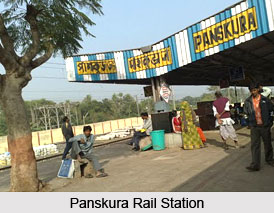 Khirpai is a well known municipality and town in Paschim Medinipur District that is located at West Bengal, India. Situated near the banks of river Shilabati and Kethai, the municipality is one of the oldest one present in India. Location of the municipality is between Ghatal and Chandrokona Town. Khirpai has rung the ladders of fame due to the availability of `Babarsha`, a special type of sweetmeat, which is not available elsewhere.
Khirpai is a well known municipality and town in Paschim Medinipur District that is located at West Bengal, India. Situated near the banks of river Shilabati and Kethai, the municipality is one of the oldest one present in India. Location of the municipality is between Ghatal and Chandrokona Town. Khirpai has rung the ladders of fame due to the availability of `Babarsha`, a special type of sweetmeat, which is not available elsewhere.
History of Khirpai
The decades of 18th and 19th century witnessed Khirpai as a giant and prominent trading sector. Raw materials like Cotton and often handicrafts of this area were exported to the foreign lands. However during the British periods owing to the interest of British rulers in the cultivation of Indigo, Khirpai became terribly famous for indigo plantation. Now it is a small town of 12 sq k.m. with a maximum population of 11,000 dwellers.
Radhamadhab Temple of Malpara is on Ghatal-Khirpai Road and 1.5 k.m. from the bus stand. This age old temple is "Pancharatna"(ratna means pinnacle) but the terracotta works still exist with glory. These works illustrate Krishnalila, Dasavatar and skirmish brawls of Ram Ravana, even hunting scenes and floral ornamentations. It was built in 1817.
The communities of French, Hollander, Portuguese and British stepped in this place for trade, as before the year 1660 and obviously by that time they thronged at Khirpai for purchasing cotton and silk, which are of exclusive status. It was obvious that in 1763, French built a workshop in this place.
It was in the 18th century that Khirpai gained acclamation for cotton-cloth weaving and manufacture of brush and bell metal. The waiving industry was again further developed in the second half of the century by the location of an important factory of East India Company in Khirpai. But however in the 19th century the Industry faced a clear water mark declination owing to the withdrawal of company from commercial undertakings and particularly due to the importing of the English piece goods. As Khirpai lost her pride as a massive business centre, the population density of Khirpai also decreases gradually at that time.

Economy of Khirpai
The main or rather principal economy of this area is agriculture and thus the society is basically agrarian. However when it comes to the rustic folks -the people of the villagers basically earn their livelihood by producing principal crops, like Paddy, Potato, Wheat, Jute and vegetables of different kinds. A few of the percentage of the people are even government employees, School Teachers and employed in numerous other small private sectors. The financial status of most of the people is in middle class and lower middle class category.
Transportation of Khirpai
Khirpai is well connected by roads/highways with other nearby cities like Midnapore, Kharagpur, Kolkata, Howrah, Ghatal, Burdwan, Panskura, Kanthi, Tamluk, Hooghly. For local transportation bus, taxi, minibus, cycle-rickshaws are available. Panskura and Chandrokona road railway stations are two nearest railway station.
Education of Khirpai
Education section at Khirpai is decorated by the numbers of schools and primary schools in Khirpai. There is one coeducational high school and one girl"s school. The names of the schools are - 1. Khirpai H.S. Multipurpose School 2. Khirpai S.K.Barman Memorial Girls High School. Ghatal Rabindra Satabarsiki Mahavidyalaya and Chandrakona Vidyasagar Mahavidyalaya are two nearest college of khirpai. There is also a vocational training institute named Dr Ambedkar Training Institute.
Culture of Khirpai
An array of religious and cultural festivals paint the map of Khirpai, and the `Santoshi Mela` is the most popular. Groups of people from Khirpai and its nearest villages indulge in the activities of Santoshi Mela. There are also some religious spots in Khirpai named Pancharatna Mandir, Parbatinath Temple, Radha Damodar Jew Temple. Radhamadhab Temple of Malpara is on Ghatal-Khirpai Road .This age old temple is "Pancharatna" (ratna means pinnacle) but however the etched terracotta works still exist with glory which reflect the Krishnalila, Dasavatar and battle of Lord Rama and Ravana, even hunting scenes and floral ornamentations. It was built in 1817. Radha Damodar Jew Temple is famous for his terracotta works. "Dalan Mandir" in Paharipara is also notable. This temple is dedicated to Singhabahini, incarnation of Devi Durga. This was built on 1746 and probably the oldest temple of Khirpai region. The massive structure of "Sitalanda Tin Temple" is situated in Hattala (Khirpai). It is facing southwards and of "atchala" style. Some terracotta specimens still can be found. It is built by Pani Family on 1839. There is a Shiva temple in the village Gangadaspur, Ward no.-6 of khirpai municipality which bears the age-old culture of this locality. This temple is almost 300 years old and it is the largest and highest of this area. This temple is newly renovated. It upholds the cultural heritage of this area. The regular Bengali festivals like Durga Puja, Saraswati Puja and Kali Puja are well attended. Other common pujas in the worship of Sitala, Jagaddhatri, Holi, Janmastami, Bheema Puja also takes place. A special type of sweet named Babarsa only in Bengal available here.



















